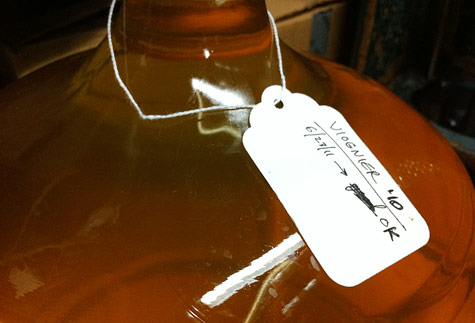Update 2010: The Troubled Ones
 … and at last we come to the wines that haven’t exactly breezed through our underground lair. Not to say they might not be lovely some day, but for now: curse you, Bacchus!
… and at last we come to the wines that haven’t exactly breezed through our underground lair. Not to say they might not be lovely some day, but for now: curse you, Bacchus!
Today, our Viognier; next, the Rosé. Hmmm: they’re both white (or white-ish) wines. Just a coincidence, you say? Ah, gentle reader, that’s why we love you…
Viognier
This is our first year with this varietal, and we unwittingly made a huge tactical error right out of the gate: we didn’t have a herky enough press to really extract everything from this notoriously thick-skinned grape. That meant a much smaller yield than was our due, but it’s probably also why our wine is so acidic — just a hair over 3.0 pH: we’re working with just juice, not the (I’m guessing) riper compounds in the grape skins that resisted our press’ embrace.
So it’s a bit on the… refreshing side. “Crisp,” one might say. A “food wine,” as the wine industry spins its more bracing effluent. Maybe even: that “mom’s secret to whiter teeth” you’ve seen manically waving its hand in the back row of every web site, urging you to call on it.
Okay, enough ganging up on our gaunt Viognier. In its defense, it does still smell utterly lovely (peaches, pears, spice) — and the acidity is likely to preserve that nicely until its infrastructure begins to soften. So with luck, it’ll simply be a wine we’ll want to lay down for a year or so before enjoying.
And we haven’t just let it sit there, shivering in its acidity. To balance the low pH with more flavor and dimension, we’ve kept it on its lees, which we’ve been stirring once a week or so. That was an invaluable tip we got from Riesling specialist and all-around brilliant winemaker Matt Berson, of Love and Squalor Wines, and it really seems to have helped.
And not content to leave barely-well-enough alone, I also thought I’d try one last gambit to offset this wine’s high pitch: I added a touch of oak. Not much, and not for long, but yeah, maybe I do have some kind of death wish where whites are concerned. The idea was to add just enough to add some depth, but not enough to oak it into chardonnay — a fate worse than… brrrr, let’s change the subject!
But after just two weeks, I pulled a sample and — Yellow my Tail! — oak vanillin already seemed to have plowed over the fragrance! I immediately yanked it off the oak and the lees, and I’ve let it sit quietly to calm itself after its brief stroll walking the streets.
Then, this morning, I thiefed a sample: time to face the music. How badly had I F’d it up? But hmmm, you know what? The oak does seem to have descended into the wine, leaving the lovely Viognier fragrance intact but adding a bit of flesh to the wine — despite its still-bracing acidity. I’d been thinking we should fine this before bottling, but maybe we ought to let whatever particulate is still there continue its broadening effect and then just decant if there’s significant settling in the bottle.
Dare I say it? The yay may well be back in our Viognier! Time will tell…
No commentsNo comments yet. Be the first.
Leave a reply
